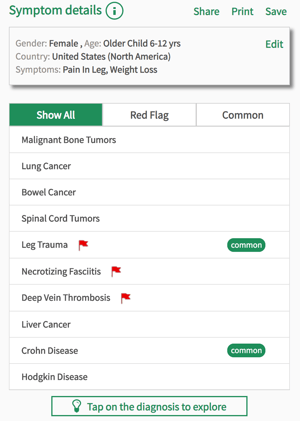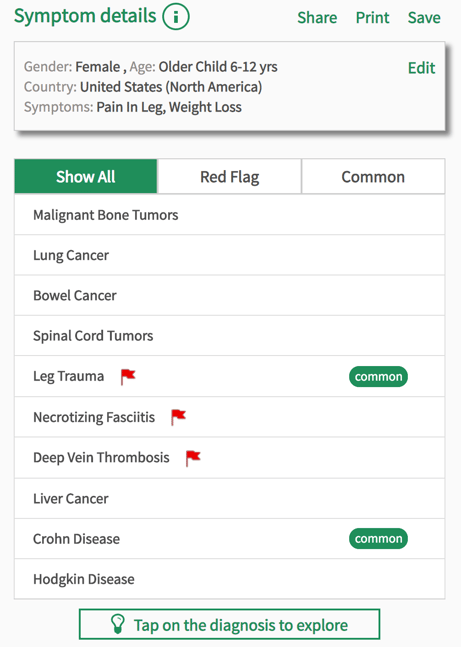- Privacy Policy
- Terms & Conditions
- Contact us
- ©Isabel Healthcare 2025
Could I have bone cancer? Bone cancer symptoms and diagnosis
 At the end of June, Nixon Whatcott from Utah, USA, passed away after an 18 month fight against bone cancer. He was just 7 years old. Because of his age, his parents assumed the pain in his leg was just ‘growing pains’ but a visit to his local hospital later revealed cancerous tumours on his leg leading to a final diagnosis of osteosarcoma, one of the most common forms of bone cancer. If the cancer hasn’t spread, survival rates of osteosarcoma can be up to 75%. Sadly Nixon’s cancer had already spread to his lungs and abdomen, reducing his chances to 30%, and after several rounds of chemotherapy, Nixon lost his battle.
At the end of June, Nixon Whatcott from Utah, USA, passed away after an 18 month fight against bone cancer. He was just 7 years old. Because of his age, his parents assumed the pain in his leg was just ‘growing pains’ but a visit to his local hospital later revealed cancerous tumours on his leg leading to a final diagnosis of osteosarcoma, one of the most common forms of bone cancer. If the cancer hasn’t spread, survival rates of osteosarcoma can be up to 75%. Sadly Nixon’s cancer had already spread to his lungs and abdomen, reducing his chances to 30%, and after several rounds of chemotherapy, Nixon lost his battle.
What is bone cancer?
Cancer occurs when cells start dividing and multiplying in an uncontrolled way to produce a tumor. The main types of bone cancer are:
- Osteosarcoma, which usually affects children, like Nixon and young adults under 20
- Ewing Sarcoma which also mainly affects people between the ages of 10-20
- Chondrosarcoma which tends to affect adults over 40
Each of these cancers affects different types of cell, so the treatment and outlook will depend on which cancer you have. You will also be told whether you have a primary or secondary cancer. Primary bone cancer starts inside the bone cells whereas secondary bone cancer spreads to the bones from another cancer that started elsewhere, most commonly as prostate, breast, lung, kidney or thyroid cancer. Primary is much the rarer of the two but the symptoms for both diseases are generally the same:
Bone cancer symptoms
Unsurprisingly, bone pain is the most common symptom. This usually starts off as a feeling of tenderness in a particular area which gradually progresses to a more persistent ache that doesn’t disappear when your body is at rest. While any bone can be affected, bone cancer most commonly develops in the long bones of the legs and arms. As in Nixon’s case, the cancer is often initially misdiagnosed as growing pains, if it occurs in children, or as arthritis in adults. Other symptoms may include:
- Increased calcium levels. You probably won’t be aware of this unless you have a blood test; indicating symptoms include tiredness, nausea, constipation, increased thirst and confusion
- A swelling or lump around the affected bone
- Bones that fracture more easily after a relatively minor fall or injury
- Problems with mobility such as stiff joints or reduced movement
- Persistent backache that gets worse, despite resting
- Neck pain
- Numbness and weakness in the legs
- Easy bruising
- A high temperature
- Unexplained weight loss
- Night sweating
What are the causes of bone cancer?
Certain things can increase your chances of developing bone cancer, namely:
- Previous radiotherapy treatment from another cancer
- Other bone conditions such as Paget’s Disease
- A history of other medical conditions such as Retinoblastoma
- Age. Like most cancers, the risk of bone cancer increases with ago, however, certain types of bone cancer, namely Osteosarcoma, are much more common in teenagers and young adults.
Diagnosis of bone cancer
It is important to remember that if you experience bone pain, it is highly unlikely to be bone cancer which is one of the rarer cancers. However, if it is getting worse you should visit your doctor who will look for any swelling or lumps and ask whether the pain has affected your mobility. You may then be referred for an x-ray and if any abnormalities appear you’ll be referred to an orthopaedic surgeon or bone cancer specialist for further assessment. The definitive way to diagnose bone cancer is by biopsy, a procedure where a sample of bone tissue is removed for examination. You may also have to have a scan which will ascertain whether the cancer has spread to other parts of your body. After this you’ll be told what stage and grade your cancer is. We’ve written before about this often confusing subject so if you’re having problems understanding the different categories and gradings of cancer, do read our blogpost on this subject.
Putting your symptoms into the Isabel Symptom Checker will also bring up some other suggestions which you can research and then discuss with your doctor.

Treatment of bone cancer
Your treatment will depend on your final diagnosis and how far your cancer has spread. Your age and general health will also be taken into account but overall, your treatment may include any or all of surgery, chemotherapy and radiotherapy. This will all be managed by an orthopaedic specialist, an oncologist (cancer specialist) and a specialist cancer nurse, who together will recommend the best form of treatment options for you. Surgery is often recommended to remove the cancerous part of the bone and it’s usually possible to avoid removing an affected body part in its entirety, though full amputations are sometimes necessary. If the cancer is near a joint, such as an elbow or knee, you may be recommended for a joint replacement.
As with any cancer, early diagnosis is key so if you have any suspicious symptoms, try entering them into the Isabel Symptom Checker and make sure you discuss them with your doctor.
Subscribe Here!
Recent Posts
Isabel DDx Companion with ChatGPT Integration - to help you diagnose even faster
At Isabel Healthcare, we’ve always been driven by one goal: to make clinical reasoning faster,..Virtual Triage: Do more questions lead to better patient outcomes?
One of the common misconceptions related to virtual triage / symptom checker tools is that the more..List Of Categories
- Differential Diagnosis Decision Support
- Differential diagnosis
- Symptom Checker
- Symptoms
- Medical Error
- Patient Disease Information
- Disease
- Clinical Decision Support
- Diagnostic Decision Support
- Isabel 1 Minute Read
- Diagnosis Error
- Diagnosis Skills Cases
- Healthcare Informatics
- Clinical Reasoning
- Evidence-based Medicine
- Medical Education
- Patient Engagement
- Symptom Triage
- Nurse Practitioner Education
- Nursing Decision Support
- Partnership
- Public Health
- COVID-19
- EHR
- Patient Empowerment
- Patient Safety
- rare disease

Start your FREE Trial today
Try the Isabel Pro DDx generator for 30-days - no payment card details required.




